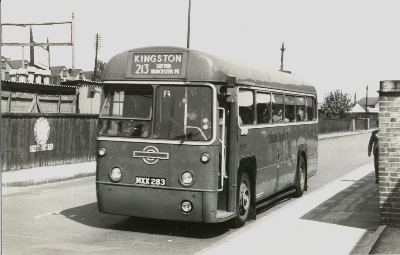KINGSTON, Norbiton, Malden, Worcester Park, North Cheam,
Cheam, Sutton, SUTTON GARAGE
... is available here.
 RFs with Semaphore Trafficators
RFs with Semaphore Trafficators
Jim Andress
RF395, one of the original
Sutton batch fitted with semaphores, the slot for which can be seen
behind the doorway (no door of course). This is a very early
photo, as the RF does not have the extra rail fitted across
the passenger windscreen. The body of RF395 (but not the
chassis, this is one of the minority where the bodies were swapped
on overhaul) ended on RF627, rather confusingly a green RF that was
repainted red (but is now green again). Got that?
Photo © Geoff Rixon, Jim
Andress collection
In late 1952 and early 1953, 24 new RFs were delivered
experimentally fitted with semaphore trafficators. All were
delivered to Sutton (A) and Norbiton (NB) garages for route
213.
Having identified those RFs that were allocated when new to A
& NB for the 213 route, they totalled 29, so presumably 5 of
them did not have semaphores. I studied all the photos I could find
of these RFs on the 213, and managed to identify some that had
semaphores and some that did not. I then checked the Vehicle
History book by Alan Bond et al, and realised that some of the RFs
which were initially allocated to the 213 at A only stayed for a
short period, some only three weeks. Since it is understood that
only RFs on the 213 used semaphores it seems rational to assume
that those that moved on were not so fitted.
As a result of following that assumption I was delighted to find
that I was left with 24 RFs that I either had seen photos of with
semaphores or that could be assumed to have had them. I them
checked the body numbers carried by the RFs allocated to the 213
when new and identified the final RF numbers they carried. I was
surprised to discover that of the 29 delivered, 7 still exist,
including some well known ones.
Those which remain are 351, 355, 366, 504, 512, 518 and 627. Of
these 504 and 518, which were originally 415 and 399, did not have
semaphores. The others, which were originally 372, 386, 390, 403
and 395 respectively, did have semaphores.
The full list of RFs initially delivered to A and NB is as
follows:-
A: 372, 374, 381, 386, 388, 393 to 407, 415, and 499, of which
374, 399, 415 and 499 did not have semaphores and were all
transferred out in a short time.
NB: 375, 379, 383, 389 to 392, of which only 375 did not have
semaphores, but remained until first overhaul.
The experiment with the semaphore trafficators was clearly not
considered satisfactory [see here,
Ed], and they were removed from the RFs. I have however not
been able to find any reference to when they were removed. It may
have been at first overhaul in 1957, and I would be interested to
know if anyone can confirm this.
This article is based on a piece by Jim Andress in the RT/RF
Register Newsletter in 2002. We are grateful to Jim and to the
Register for permission to publish it here. Jim's closing
question still stands - can anyone help?